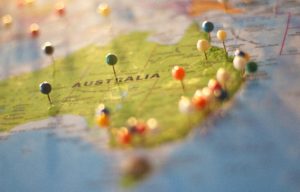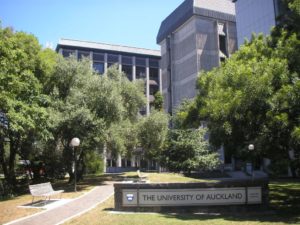Medical education was in the news in Australia recently, with more than 1000 international med students allowed through a stringent non-citizen border system that has been in place for much of the COVID-19 global pandemic.
While the recent tweak of Australia’s border rules that allowed them to enter has been used as a political football by some, the nation’s medical field is celebrating a move in a country, like the United States, that is suffering from a growing shortage of practicing physicians.
“If medical students can’t get back into the country, then this will impact the pipeline of new doctors into the system over the next few years,” Vicki Thomson, head of the Group of Eight, a powerful body that represents Australia’s top universities, says. “There will be a shortfall.”
Though largely cocooned from the dramatic impact the COVID-19 pandemic has had on the U.S. and most other nations, the geographic isolation of both Australia and New Zealand still isn’t enough to exclude it from the issues that plague medicine—and medical education—worldwide.
From problems with their own med school pathways to continuing struggles with equity and student debt, the South Pacific duo offer a med school experience that rhymes with the American one, without repeating it.
Med school in the Antipodes
New Zealand has only two med schools; the University of Otago and the University of Auckland. Generally students can apply to enter the med school program after completing a single undergraduate biomedical sciences year, with entry pathways also existing for prior graduates.
Once a student successfully enters med school, they will study for five more years. Depending on the school, students take two or three preclinical years before being deeply immersed into medical science in their clinical years. Rural, research, and international elective options also exist. In their sixth and final year, Kiwi med students become ‘trainee interns’, gradually becoming fully responsible for patient care.
The clinical experience in year three and four are more focused on diagnosis, management and treatment of disease, in addition to building patient rapport. The way I learn and engage with the degree has changed quite a bit as a result of this shift in teaching style.
Over the Ditch, Australia has 21 medical schools, offering similar undergraduate and graduate entry, but with graduates taking a shorter course of study. Depending on the institution selected, this allows undergrads to select a major before getting into a four-year graduate program for medicine. Entry is based on their undergraduate grade point average (GPA), their Graduate Medical School Admissions Test (GAMSAT) score, and an interview, if required.
One New Zealand-born recent medical graduate, who didn’t wish to give her name, says this shorter course of study has its drawbacks, however.
Studying medicine in Australia through graduate entry after an arts degree in psychology, she passed all the entry requirements, but still doesn’t feel particularly comfortable with her medical science foundation.
“If you’ve done no science [in your first degree] you are qualifying as a doctor with a very shallow understanding of a lot of really important concepts,” she says. “If people like me do it from my background, it’s a short period of time to do the learning.”
She sees it as a trade-off between allowing in students who are more well-rounded, but, at the same time, may not have obtained as much specialist knowledge.

After attending med school for four to six years, Australian students become junior medical officers. They spend a year as a supervised intern at a clinical site, gain more clinical experience and responsibility by working for a year or more as a resident, usually in a hospital. Differing from the terms used in the US, ‘intern’ and ‘resident’ are used for doctors that have yet to move into specialist fields.
“The clinical experience in year three and four are more focused on diagnosis, management and treatment of disease, in addition to building patient rapport,” Aspasia Manos, a Candian med student studying through the University of Sydney, said in 2019.
“The way I learn and engage with the degree has changed quite a bit as a result of this shift in teaching style.”
On both sides of the Tasman Sea, specialist vocational training pathways as junior registrar or trainee specialists follow, ensuring several more years of on-the-job training as either a general practitioner, specialist consultant, or non-specialist career hospital doctor (hospitalist).
Once a senior registrar, future doctors study to become a fellow of a specialist college, such as the Australian and New Zealand College of Anesthetists, or the Royal Australasian College of Surgeons. At this point, new physicians can practice medicine unsupervised and independently in their chosen field, and become a specialist.
Similarities and differences
Dr Fabian Schwarz, an Australian and Canadian-trained rural general practitioner with a special interest in med school education, says one bonus of the Australasian systems, compared to the US, is they produce doctors faster – between five and six years is the quickest way.
“It just means if you have a shortage of doctors, which we do have (in Australasia), [you] can supply your own medical force without having to import doctors,” Schwarz says.
Due to both an aging populations, and an aging medical workforces, there are shortages of doctors in all three countries. In June 2020, an Association of American Medical Colleges (AAMC) study projected a shortfall of up to 139,000 physicians by 2033, especially for Black and Latino doctors, and the ongoing Covid-19 pandemic is making that worse, according to Patrice Harris, MD, president of the American Medical Association (AMA).
In New Zealand, there is a 25 percent shortage of specialists, with 43 percent of those practicing trained overseas. A shortage of general practitioners in both New Zealand and Australia also exists, with, like the U.S, rural areas facing less access to medical expertise.
It just means if you have a shortage of doctors, which we do have (in Australasia), [you] can supply your own medical force without having to import doctors.
Regardless of the three countries’ training differences, all three face similar issues with racial and gender disparities across the health system. These are directly reflected, at medical school.
Now a medical evaluator for Health Canada, Schwarz says the issue is systemic: “it’s the same across all healthcare, including healthcare systems, hospitals, universities, and medical schools.”
Like the U.S, racial and gender disparities and discrimination in the med school years follow through into the medical system itself in both Australia and New Zealand, affecting not just patient care but also doctors’ abilities and their ease in relating to people of minority backgrounds.
In both quality, and frequency of treatment, there are widely documented disparities for indigenous, racial, and ethnic minorities in both Australia, and New Zealand.
New Zealand’s population is 15 percent Māori and 8 percent Pacific Island-New Zealander, but those proportions fall to 3.4 percent and 1.8 percent in the medical workforce.
A proportion of student places is set aside at both New Zealand medical schools in order to admit medical those who better reflect the makeup of society, including a rural, refugee, or low-socioeconomic background – as well as ethnicity.
The University of Otago has implemented a ‘Mirror on Society’ policy to try and address these differences and achieve a representative health workforce, drawing support from Prime Minister Jacinda Ardern and Ashley Bloomfield, New Zealand’s Director-General of Health.

Last year, Professor Peter Crampton, one of the creators of Otago’s Mirror on Society affirmative action policy, said it was “completely unacceptable to have a health workforce devoid of Māori,” and that high marks alone should not be “a passport” to becoming a doctor.
In Australia, universities such as Melbourne’s Deakin University, also offer an entry stream for indigenous Aboriginal and Torres Strait Islander students, to redress the lack of representation in the workforce, which is 0.5 percent compared to 3 percent of the general population.
The Australian Indigenous Doctors’ Association’s aim is to for the country to reach a representative proportion of Indigenous doctors and medical students in the country. That means going from 483 doctors currently registered to 3139; and from 310 Indigenous medical students to 429.
Like most fields of study across the three nations, affirmative action—or ‘preferential entry pathways’—in medicine can draw strong opposition, legal challenge, and is often subject to political whim.
A check in the mail
Schwarz says there are also socio-economic factors influencing who can afford to enter medical school, based on the cost of medical education.
Australia’s Higher Education Loan Program (HELP)—considered to be one of the most generous in the world—is effectively interest-free. Australian med students are lucky in that if they’re an eligible Australian citizen, their contribution to medical school in 2021 is capped at A$11,300 a year (around US$8700) with the government paying the rest.
With its public and private student loan system, the U.S can be astronomical by comparison. According to Education Data, the average total student debt among medical school graduates in the US is now US$241,600. The figure is closer to US$50,000 in both New Zealand and Australia.
[American students] have a huge debt compared to Australia and New Zealand. That means your starting point as a junior doctor between those countries is very, very different.
“I think the equity is a bit better in Australia as opposed to New Zealand, because you’ve got more choice in more universities you can choose from,” Schwarz says. “But in the United States, your equity is very different.”
“If you just take a social perspective on it, if you don’t have money it’s very hard to get in,” Schwarz continues, talking about the US system.
“Even if you’re really bright … you might get a scholarship, but it’s very tough, so often you do need the financial backing.
“Once they’ve finished their degree, [American students] have a huge debt compared to Australia and New Zealand. That means your starting point as a junior doctor between those countries is very, very different.”



